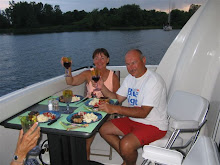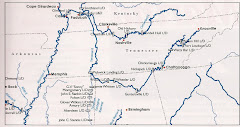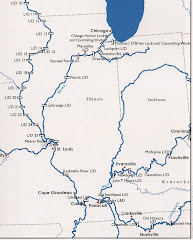Since I was last into the anchorage, we were first out in the morning. In fact, we were off by 7:45 and away earlier than the others. It may have been a mistake not waiting for the others but I wanted to get to Green Turtle Bay, our next marina, in 2 days rather than the three needed by the others. Since the channel was fairly close to the entrance of our anchorage, I did the “securite, securite” announcement over the radio and then headed out. No problem for 5 minutes at least. Then an oncoming tow; still no problem; I contacted the tow captain and he requested a one whistle pass. No problem. Have I explained the terminology that the tow captains use? One whistle or see you on the one means that you keep to the right, that is port side to port side. A two whistle pass or two is starboard side to starboard side or go to the left of the oncoming tow. When overtaking a tow, one whistle means overtake on the right; two whistles mean overtake on the left.
Almost immediately we encountered another tow and proceeded in the proper fashion; no problem. There was an awful lot of turbulence when the tow passed and it was lumpy for quite awhile but we were getting fairly used to this. Almost immediately we encountered another tow only this time it was on a bend in the river. The tow captain told me a one whistle pass but to go inside the green buoys because he needed to cut the corner in order to make the turn. No problem until the current started sliding us towards the barges as we were making the turn. On this pass I stayed a little closer to the barge than I normally would have because I was outside the channel markers. What I didn’t realize was the amount of side slipping that was occurring in a turn due to the current until I could see us getting closer and closer to the barges. About the same time that I was goosing my engines to get out of there the tow captain came over the radio suggesting that I might want to move over more. The power of the current caught me by surprise somewhat, but I was able to power my way out of the situation. I am not sure that some of the other trawlers would have been able to do that as easily as I had. At least the tow captain had a sense of humour. When I said that I was reluctant to go too far out of the channel he came back and said that I did not have enough hanging below to worry about.
The next tow was less than 2 minutes behind the one that I was still talking to. We were on a straight stretch, contacted the captain, agreed to meet on the one and passed this rather large tow. The next thing that I know is that my bow is in the water. The surge was so strong and the waves so steep that I went up one side and right down into the next and my bow pulpit touched the top of the wave. We got tossed around quite a bit by that tow. All this occurred before I had even started my second coffee. In fact, that morning we came face to face with 7 tows in the first 40 minutes after leaving our anchorage.
Welcome to the Mississippi River.
The river widened just after we passed all those barges and it was as smooth as could be so I could see the floating debris from quite a distance. I brought Q up on plane for awhile and managed to reach 32 mph. That is good for Q because he would normally only be able to manage 25 mph in calm waters. I doubt that we stayed on plane for a full hour but it felt good none the less and before we knew it we had reached the junction to the Ohio River.
We were making good time and decided to go to the town of Paducah in Tennessee. Friends on Lazy Dolphin spent the previous night there and just raved about the town. We were doing fine on this beautiful sunny day until we approached Lock # 52. About 5 miles before the lock we heard the lock master tell two other pleasure crafters (that is lock master speak for pleasure boaters) to go anchor out of the way for a couple of hours. I immediately backed down on my speed and turned one engine off. It took us about 1 ½ hours to reach the dam at idle speed on a single engine. It was so calm below the dam that I did not have to bother with an anchor. I floated for another hour and only had to start an engine once to reposition.
It was an ugly lock which is why it is being replaced by a new lock and dam downstream, called Olmstead Dam. Anyway, the walls of the lock are not flat or straight; they are huge, rusted, steel cylinders about 15 feet across. We heard that some boaters were required to loop 50 foot lines around bollards at the top and then try to keep their boats off the ugly cylinders as they were lifted. Fortunately for the three of us, they allowed us to float in the center of the lock while they lifted us the 5 feet necessary to clear the dam. It was only 5 feet because the Mississippi was at flood levels so the Ohio was up as well, at least in that lower pool. From the lock it was only about 5 miles to Paducah but it was getting late.
We easily found the junction to the Tennessee River where the town of Paducah was located. It was getting late and we did not like the looks of the small courtesy dock because it was so exposed and very near the channel which was a staging area for a tow company so we searched for an anchorage nearby. One of the guide books suggested a tenable (eg. shoaling and depth issues at times) anchorage on the south side of Cuba Head Island on the Tennessee River. We found it but we were a little concerned because there were docks and cranes on that same south side. We went further on and found about 15 feet of water where we were out of the way of the cranes and about 100 yards off the Tennessee River. Our first attempt at setting the anchor did not hold. It was getting dark already so we were getting a little anxious; after all we were alone for the first time. Fortunately, the second attempt held us tight. I was so confident with the set that after our BBQ and watching some TV, I fell asleep immediately and was ready to go 8 hours later….at 5 AM. I was surprised when I got up that a barge was approaching in the dark. (Aside: At night all of the tow boats have powerful spotlights that can shine, it seems a quarter of a mile or more. I am not exaggerating because they do light up the path clearly in front of tows that have six barges attached end to end. Since each barge is 35’ by 100’ long, I rest my case.) This tow captain left a full barge of sand under one of the cranes and then took off. Linda never heard a thing. Since Linda has never left her bed earlier than 7, I had a chance to work on my blog.
When Linda did get up (to the fresh coffee that I prepare each and every morning) we got ready and had no problems retrieving the anchor. It was not even muddy as we must have anchored in some of the sand that is all around. We headed back out past the now nearly empty barge onto the Tennessee and back to the Ohio River to continue our journey to Green Turtle Bay Marina.









No comments:
Post a Comment